On the Way of Policy Making to Reduce the Reliance of Fossil Fuels: Case Study of Iran
Abstract
1. Introduction
1.1. Iran Energy System and Structure
1.2. Paper Organization
1.3. Literature Review
2. Renewable Energy Potentials
2.1. Wind Energy
2.2. Solar Energy
2.3. Geothermal Energy
2.4. Hydropower
2.5. Bio-Energy
2.6. Marine Energy
2.7. Fuel Cell and Hydrogen
2.8. Summary
3. Renewable Energy Policy, Market, and Status
3.1. World Status
3.2. Iran Status
3.2.1. Iran’s Policymaking
3.2.2. Investment Trend and Procedure
- Project registration
- Presentation of technical and financial plans in detail (including the site) and feasibility study of the project
- Registration of the project and construction permission issuance following meeting the criteria such as investor’s Iranian nationality and non-governmental identity and verification of feasibility study and site location as well.
- Permits and certifications
- Obtaining grid connection, environment, and site land permits from authorities for all power plants and water flow allocation for hydropower plants
- Signing a long term power purchase agreement (PPA) following confirmation of permits.
- Power plant construction
- Initial and operational development of the project along with financial support by developer
- Coordination for connection to power grid after the completion of the power plant.
- Operation period
- Commencing power plant operation and preparation of monthly bill with regard to renewable energy price by developer
- Payment of bills by SATBA (Renewable Energy and Energy Efficiency Organization) applying adjustment coefficient [136].
3.2.3. Challenges and Obstacles
- Finical issues
- Credit validity of SATBA
- Shortage of Knowledge and experience
- Bureaucracy and regulations
- Land acquisition
4. Conclusions
Author Contributions
Funding
Conflicts of Interest
References
- Sáenz, R.; Embrick, D.G.; Rodríguez Editors, N.P. International Handbooks of Population 4 The International Handbook of the Demography of Race and Ethnicity; Springer: New York, NY, USA, 2015. [Google Scholar]
- United Nations Website 2018. Available online: http://data.un.org/en/iso/ir.html (accessed on 15 October 2018).
- Hosseini, S.E.; Andwari, A.M.; Wahid, M.A.; Bagheri, G. A review on green energy potentials in Iran. Renew. Sustain. Energy Rev. 2013, 27, 533–545. [Google Scholar] [CrossRef]
- Fathi, S.; Lavasani, A.M. A Review of Renewable and Sustainable Energy Potential and Assessment of Solar Projects in Iran. J. Clean. Energy Technol. 2017, 5, 126–130. [Google Scholar] [CrossRef]
- Sabetghadam, M. Energy and Sustainable Development in Iran. Sustain. Energy Watch 2005, 1, 1–41. [Google Scholar]
- Norouzi, N.; Fani, M. The prioritization and feasibility study over renewable technologies using fuzzy logic: A case study for Takestan plains. Res. Artic. J. Energy Manag. Technol. 2020, 5, 12. [Google Scholar] [CrossRef]
- Tofigh, A.A.; Abedian, M. Analysis of energy status in Iran for designing sustainable energy roadmap. Renew. Sustain. Energy Rev. 2016, 57, 1296–1306. [Google Scholar] [CrossRef]
- OPEC (Organization of the Petroleum Exporting). Annual Statistical Bulletin; Organization of the Petroleum Exporting: Wienna, Austria, 2004; ISSN 0475-0608. [Google Scholar]
- BP. BP Statistical Review of World Energy-Oil. 2018. Available online: https://www.bp.com/en/global/corporate/energy-economics/statistical-review-of-world-energy.html (accessed on 20 December 2018).
- EIA (Energy Information Administration). Country Analysis Brief: Iran; Energy Information Administration: Washington, DC, USA, 2018. [Google Scholar]
- Kazemi Karegar, H.; Zahedi, A.; Ohis, V.; Taleghani, G.; Khalaji, M.; Karegar, H.K. Wind and solar energy development in Iran. North Amir Abad, Tehran/Iran. Cent. Renew. Energy Res. Appl. 2006, 1, 1–6. [Google Scholar]
- Brown, C.E. World Energy Resources 2016-Coal; Springer: Berlin/Heidelberg, Germany, 2016. [Google Scholar] [CrossRef]
- Ghobadian, B. Liquid biofuels potential and outlook in Iran. Renew. Sustain. Energy Rev. 2012, 16, 4379–4384. [Google Scholar] [CrossRef]
- Nejat, P.; Morsoni, A.K.; Jomehzadeh, F.; Behzad, H.; Saeed Vesali, M.; Majid, M.Z.A. Iran’s achievements in renewable energy during fourth development program in comparison with global trend. Renew. Sustain. Energy Rev. 2013, 22, 561–570. [Google Scholar] [CrossRef]
- Iran’s National Institute of Statistics—Statistics of Iran. Available online: www.amar.org.ir (accessed on 21 October 2018).
- Kamran Azadi, A.; Yarmohammad, M.H. Analysis of Iran’s crude oil export future capacity. Energy Policy 2011, 39, 3316–3326. [Google Scholar] [CrossRef]
- Ministry of Energy. Energy Balance Sheet of Iran; Ministry of Energy: Tehran, Iran, 2015. [Google Scholar]
- Afsharzade, N.; Papzan, A.; Ashjaee, M.; Delangizan, S.; Van Passel, S.; Azadi, H. Renewable energy development in rural areas of Iran. Renew. Sustain. Energy Rev. 2016, 65, 743–755. [Google Scholar] [CrossRef]
- Mostafaeipour, A.; Sedaghat, A.; Dehghan-Niri, A.A.; Kalantar, V. Wind energy feasibility study for city of Shahrbabak in Iran. Renew. Sustain. Energy Rev. 2011, 15, 2545–2556. [Google Scholar] [CrossRef]
- Arefi, F.; Moshtagh, J.; Moradi, M. The Wind Energy Potential of Kurdistan, Iran. Int. Sch. Res. Not. 2014, 2014, 1–10. [Google Scholar] [CrossRef] [PubMed]
- Omidiani, A.; HashemiHezaveh, S. Solar Energy and Its Future Role in India and Iran. Int. J. Sci. Res. Publ. 2015, 5, 1–8. [Google Scholar]
- Meisen, P.; Hunter, L. Renewable Energy Potential of the Middle East, North Africa vs. the Nuclear Development Option. Glob. Energy Netw. Inst. 2007, 1, 1–33. [Google Scholar]
- Hamid, B.; Bagher, A.M.; Reza, B.M.; Mahboubeh, B. Review of sustainable energy sources in Kerman. World J. Eng. 2016, 13, 109–119. [Google Scholar] [CrossRef]
- Country Programming Framework (CPF) for Iran’s Agriculture Sector Prepared by Government of Islamic Republic of Iran (GOI)/Ministry of Jihad-e-Agriculture (MOJA) and Food and Agriculture Organization (FAO) of the United Nations; MOJA: Tehran, Iran, 2016; Available online: http://www.fao.org/fileadmin/user_upload/faoweb/iran/docs/CPF_Iran_FAO_2012-2016.pdf (accessed on 17 September 2019).
- Kim, S.; Dale, B.E. Global potential bioethanol production from wasted crops and crop residues. Biomass Bioenergy 2004, 26, 361–375. [Google Scholar] [CrossRef]
- Ghorashi, A.H.; Rahimi, A. Renewable and non-renewable energy status in Iran: Art of know-how and technology-gaps. Renew. Sustain. Energy Rev. 2011, 15, 729–736. [Google Scholar] [CrossRef]
- Mohammadnejad, M.; Ghazvini, M.; Mahlia, T.M.I.; Andriyana, A. A review on energy scenario and sustainable energy in Iran. Renew. Sustain. Energy Rev. 2011, 15, 4652–4658. [Google Scholar] [CrossRef]
- Mollahosseini, A.; Hosseini, S.A.; Jabbari, M.; Figoli, A.; Rahimpour, A. Renewable energy management and market in Iran: A holistic review on current state and future demands. Renew. Sustain. Energy Rev. 2017, 80, 774–788. [Google Scholar] [CrossRef]
- Najafi, G.; Ghobadian, B. Geothermal resources in Iran: The sustainable future. Renew. Sustain. Energy Rev. 2011, 15, 3946–3951. [Google Scholar] [CrossRef]
- Ramazankhani, M.E.; Mostafaeipour, A.; Hosseininasab, H.; Fakhrzad, M.B. Feasibility of geothermal power assisted hydrogen production in Iran. Int. J. Hydrogen Energy 2016, 41, 18351–18369. [Google Scholar] [CrossRef]
- Kumar, A. Small Hydropower Development in Iran: An IWPC Input To Ministry of Energy, IRI Ministry of Energy: Tehran, Iran. 2005, pp. 1–55. Available online: https://www.iwpco.ir (accessed on 7 October 2019).
- International Hydropower Association/Iran. 2017, pp. 1–2. Available online: https://www.hydropower.org/country-profiles/iran (accessed on 20 October 2018).
- Khojasteh, D.; Kamali, R. Evaluation of wave energy absorption by heaving point absorbers at various hot spots in Iran seas. Energy 2016, 109, 629–640. [Google Scholar] [CrossRef]
- Khojasteh, D.; Khojasteh, D.; Kamali, R.; Beyene, A.; Iglesias, G. Assessment of renewable energy resources in Iran; with a focus on wave and tidal energy. Renew. Sustain. Energy Rev. 2018, 81, 2992–3005. [Google Scholar] [CrossRef]
- IRENA-Interntional Renewable Enrgy Agancy. 2020. Available online: https://www.irena.org/ (accessed on 28 March 2020).
- Aghahosseini, A.; Bogdanov, D.; Ghorbani, N.; Breyer, C. Analysis of 100% renewable energy for Iran in 2030: Integrating solar PV, wind energy and storage. Int. J. Environ. Sci. Technol. 2018, 15, 17–36. [Google Scholar] [CrossRef]
- Asadi Asad Abad, M.R.; Moharrampour, M.; Abdollahian, H.; Shir Ali, M.; Mohagheghzadeh, F. Developing Renewable Energies in Iran. Int. J. Energy Inf. Commun. 2012, 3, 17–28. [Google Scholar]
- Ghobadian, B.; Najafi, G.; Rahimi, H.; Yusaf, T.F. Future of renewable energies in Iran. Renew. Sustain. Energy Rev. 2009, 13, 689–695. [Google Scholar] [CrossRef]
- Chaharsooghi, S.K.; Rezaei, M.; Alipour, M. Iran’s energy scenarios on a 20-year vision. Int. J. Environ. Sci. Technol. 2015, 12, 3701–3718. [Google Scholar] [CrossRef]
- Atabi, F. Renewable energy in Iran: Challenges and opportunities for sustainable development. Int. J. Environ. Sci. Technol. 2004, 1, 69–80. [Google Scholar] [CrossRef]
- Khoshnevis Yazdi, S.; Shakouri, B. Renewable energy, nonrenewable energy consumption, and economic growth. Energy Sources Part B Econ. Plan. Policy 2017, 12, 1038–1045. [Google Scholar] [CrossRef]
- Kumar, A.; Prasad, S. Examining wind quality and wind power prospects on Fiji Islands. Renew. Energy 2010, 35, 536–540. [Google Scholar] [CrossRef]
- Mostafaeipour, A.; Jadidi, M.; Mohammadi, K.; Sedaghat, A. An analysis of wind energy potential and economic evaluation in Zahedan, Iran. Renew. Sustain. Energy Rev. 2014, 30, 641–650. [Google Scholar] [CrossRef]
- Gökçek, M.; Bayülken, A.; Bekdemir, Ş. Investigation of wind characteristics and wind energy potential in Kirklareli, Turkey. Renew. Energy 2007, 32, 1739–1752. [Google Scholar] [CrossRef]
- Liu, C.; Li, Q.; Zhao, W.; Wang, Y.; Ali, R.; Huang, D.; Lu, X.; Zheng, H.; Wei, X. Spatiotemporal Characteristics of Near-Surface Wind in Shenzhen. Sustainability 2020, 12, 739. [Google Scholar] [CrossRef]
- Islam, M.R.; Saidur, R.; Rahim, N.A. Assessment of wind energy potentiality at Kudat and Labuan, Malaysia using Weibull distribution function. Energy 2011, 36, 985–992. [Google Scholar] [CrossRef]
- World Wind Energy Association. World Wind Energy-Report 2009; World Wind Energy Association: Bonn, Germany, 2009. [Google Scholar]
- U.S. Department of Energy. Wind Power Today: 2010; U.S. Department of Energy: Washington, DC, USA, 2010. [Google Scholar]
- Saidur, R.; Rahim, N.A.; Islam, M.R.; Solangi, K.H. Environmental impact of wind energy. Renew. Sustain. Energy Rev. 2011, 15, 2423–2430. [Google Scholar] [CrossRef]
- The Wind Power. Wind Energy Market Actors. 2018. Available online: https://www.thewindpower.net/statistics_en.php (accessed on 4 November 2018).
- Nedaei, M. Wind energy potential assessment in Chalus County in Iran. Int. J. Renew. Energy Res. 2012, 2, 338–347. [Google Scholar]
- Mostafaeipour, A.; Mostafaeipour, N. Renewable energy issues and electricity production in Middle East compared with Iran. Renew. Sustain. Energy Rev. 2009, 13, 1641–1645. [Google Scholar] [CrossRef]
- Zarma, L. The status of wind energy in Nigeria and its technology overview. In Proceedings of the World Wind Energy Conference, Copenhagen, Denmark, 26–28 October 2005. [Google Scholar]
- International Persian Group (IPG). The Renewable Energy Market of Iran. 2017, pp. 1–11. Available online: http://ipg-co.com/blog/the-renewable-energy-market-of-iran.html (accessed on 1 February 2019).
- Global Wind Energy Council. Global Wind Energy Outlook 2010; Global Wind Energy Council: Brussel, Belgium, 2010. [Google Scholar]
- Fadai, D. The feasibility of manufacturing wind turbines in Iran. Renew. Sustain. Energy Rev. 2007, 11, 536–542. [Google Scholar] [CrossRef]
- Moslem Mousavi, S.; Bagheri Ghanbarabadi, M.; Bagheri Moghadam, N. The competitiveness of wind power compared to existing methods of electricity generation in Iran. Energy Policy 2012, 42, 651–656. [Google Scholar] [CrossRef]
- Kamali, S.M.; Manshadi, M.D. Assessment of Wind Energy Potential for City of Firoozkooh in Iran. In Proceedings of the International Conference on Mathematics and Computers in Sciences and in Industry, Varna, Bulgaria, 13–15 September 2014. [Google Scholar] [CrossRef]
- Mostafaeipour, A.; Mohammadi, K.; Sabzpooshan, M. Wind-solar energy potentials for three free trade and industrial zones of Iran. In Proceedings of the Fifth International Conference on Industrial Engineering and Operations Management (IEOM 2015), Dubai, UAE, 3–5 March 2015. [Google Scholar] [CrossRef]
- Tizpar, A.; Satkin, M.; Roshan, M.B.; Armoudli, Y. Wind resource assessment and wind power potential of Mil-E Nader region in Sistan and Baluchestan Province, Iran—Part 1: Annual energy estimation. Energy Convers. Manag. 2014, 79, 273–280. [Google Scholar] [CrossRef]
- Nedaei, M.; Assareh, E.; Biglari, M. An extensive evaluation of wind resource using new methods and strategies for development and utilizing wind power in Mah-shahr station in Iran. Energy Convers. Manag. 2014, 81, 475–503. [Google Scholar] [CrossRef]
- Mirhosseini, M.; Sharifi, F.; Sedaghat, A. Assessing the wind energy potential locations in province of Semnan in Iran. Renew. Sustain. Energy Rev. 2011, 15, 449–459. [Google Scholar] [CrossRef]
- Mohammadi, K.; Mostafaeipour, A.; Sabzpooshani, M. Assessment of solar and wind energy potentials for three free economic and industrial zones of Iran. Energy 2014, 67, 117–128. [Google Scholar] [CrossRef]
- Mostafaeipour, A.; Sedaghat, A.; Ghalishooyan, M.; Dinpashoh, Y.; Mirhosseini, M.; Sefid, M.; Pour-Rezaei, M. Evaluation of wind energy potential as a power generation source for electricity production in Binalood, Iran. Renew. Energy 2013, 52, 222–229. [Google Scholar] [CrossRef]
- Fazelpour, F.; Soltani, N.; Soltani, S.; Rosen, M.A. Assessment of wind energy potential and economics in the north-western Iranian cities of Tabriz and Ardabil. Renew. Sustain. Energy Rev. 2015, 45, 87–99. [Google Scholar] [CrossRef]
- Mostafaeipour, A. Feasibility study of harnessing wind energy for turbine installation in province of Yazd in Iran. Renew. Sustain. Energy Rev. 2010, 14, 93–111. [Google Scholar] [CrossRef]
- Tezerjani, M.D. The Analysis of Wind Power Potential in Kerman Synoptic Stations, Iran—An Estimation Using the Weibull Density Function. J. Climatol. Weather Forecast 2015, 3, 1–13. [Google Scholar] [CrossRef]
- SATBA (Renewable Energy and Energy Efficiency Organization). 2018. Available online: http://www.satba.gov.ir (accessed on 14 December 2018).
- Fazelpour, F.; Markarian, E.; Soltani, N. Wind energy potential and economic assessment of four locations in Sistan and Balouchestan province in Iran. Renew. Energy 2017, 109, 646–667. [Google Scholar] [CrossRef]
- GWEC (Global Wind Energy Council). Global Wind Energy Outlook 2014; Glob Wind Energy Council: Brussels, Belgium, 2014; pp. 1–60. [Google Scholar] [CrossRef]
- Bahrami, M.; Abbaszadeh, P. An overview of renewable energies in Iran. Renew. Sustain. Energy Rev. 2013, 24, 198–208. [Google Scholar] [CrossRef]
- Delucchi, M.A.; Jacobson, M.Z. Providing all global energy with wind, water, and solar power, Part II: Reliability, system and transmission costs, and policies. Energy Policy. 2011, 39, 1170–1190. [Google Scholar] [CrossRef]
- Gulaliyev, M.G.; Mustafayev, E.R.; Mehdiyeva, G.Y. Assessment of solar energy potential and its ecological-economic efficiency: Azerbaijan case. Sustainability 2020, 12, 1116. [Google Scholar] [CrossRef]
- Najafi, G.; Ghobadian, B.; Mamat, R.; Yusaf, T.; Azmi, W.H. Solar energy in Iran: Current state and outlook. Renew. Sustain. Energy Rev. 2015, 49, 931–942. [Google Scholar] [CrossRef]
- Dehghan, A.A. Status and potentials of renewable energies in Yazd Province-Iran. Renew. Sustain. Energy Rev. 2011, 15, 1491–1496. [Google Scholar] [CrossRef]
- Noorollahi, Y.; Yousefi, H.; Itoi, R.; Ehara, S. Geothermal energy resources and development in Iran. Renew. Sustain. Energy Rev. 2009, 13, 1127–1132. [Google Scholar] [CrossRef]
- Fridleifsson, I.B. Geothermal energy for the benefit of the people. Renew. Sustain. Energy Rev. 2001, 5, 299–312. [Google Scholar] [CrossRef]
- Ramezani, A.; Torshizi, M.V.; Attari, A.; Tabarsa, F. Generating Electricity Using Geothermal Energy in Iran. J. Renew. Sustain. Energy Rev. 2018, 4, 42–55. [Google Scholar]
- Youse, A.; Sasaki, K.; Youse, H.; Pirasteh, S.; Sugai, Y. GIS aided prediction of CO 2 emission dispersion from geothermal electricity production. J. Clean. Prod. 2011, 19, 1982–1993. [Google Scholar] [CrossRef]
- International Hydrpower Association. 2018 Hydropower Status Report; International Hydrpower Association: Romford, UK, 2018. [Google Scholar]
- Bartle, A. Hydropower potential and development activities. Energy Policy 2002, 30, 1231–1239. [Google Scholar] [CrossRef]
- Iran Water Resources Managment. Hydropower Plants in Iran. 2017. Available online: http://www.wrm.ir/SC.php?type=static&id=562 (accessed on 18 November 2018).
- Iran to Build Dozens of Small Hydro Plants in Indonesia Through 2020. 2017. Available online: http://www.hydroworld.com/articles/2015/05/iran-to-build-dozens-of-small-hydro-plants-in-indonesia-through-2020.html (accessed on 11 November 2018).
- World Energy Resources Bioenergy. 2016. Available online: https://www.worldenergy.org/publications/entry/world-energy-resources-2016 (accessed on 11 November 2019).
- Kazem, H.A. Renewable energy in Oman: Status and future prospects. Renew. Sustain. Energy Rev. 2014, 15, 3465–3469. [Google Scholar] [CrossRef]
- Kumar, A.; Kumar, K.; Kaushik, N.; Sharma, S.; Mishra, S. Renewable energy in India: Current status and future potentials. Renew. Sustain. Energy Rev. 2010, 14, 2434–2442. [Google Scholar] [CrossRef]
- IRENA. REmap: Roadmap for a Renewable Energy Future, 2016; International Renewable Energy Agancy: Bonn, Germany, 2016; p. 172. [Google Scholar] [CrossRef]
- Madadi, M.; Hoseini, S.M.; Khalili, I.; Abbas, A. A review on renewable energy resources in Iran. In Proceedings of the IInternational Conference on Sustainable Development, Strategies and Challenges, with a Focus on Agriculture, Natural Resources, Environment and Tourism, Tabriz, Iran, 7–9 March 2017. [Google Scholar]
- Huu Hoang, N.; Fogarassy, C. Sustainability Evaluation of Municipal Solid Waste Management System for Hanoi (Vietnam)—Why to Choose the ‘Waste-to-Energy’ Concept. Sustainability 2020, 12, 1085. [Google Scholar] [CrossRef]
- Taghizadeh-alisaraei, A.; Hasan, S.; Ghobadian, B.; Motevali, A. Biofuel production from citrus wastes: A feasibility study in Iran. Renew. Sustain. Energy Rev. 2016, 1–13. [Google Scholar] [CrossRef]
- Taghizadeh-Alisaraei, A.; Assar, H.A.; Ghobadian, B.; Motevali, A. Potential of biofuel production from pistachio waste in Iran. Renew. Sustain. Energy Rev. 2017, 72, 510–522. [Google Scholar] [CrossRef]
- Ghorbani, A.; Rahimpour, M.R.; Ghasemi, Y.; Raeissi, S. The Biodiesel of Microalgae as a Solution for Diesel Demand in Iran. Energies 2018, 11, 950. [Google Scholar] [CrossRef]
- Mohammad, S.; Ardebili, S.; Khademalrasoul, A. An Analysis of Liquid-Biofuel Production Potential from Agricultural Residues and Animal Fat (Case Study: Khuzestan Province). J. Clean. Prod. 2018. [Google Scholar] [CrossRef]
- Zareei, S. Evaluation of biogas potential from livestock manures and rural wastes using GIS in Iran. Renew. Energy 2018, 118, 351–356. [Google Scholar] [CrossRef]
- Moosavi, S.A.; Aghaalikhani, M.; Ghobadian, B.; Fayyazi, E. Okra: A potential future bioenergy crop in Iran. Renew. Sustain. Energy Rev. 2018, 93, 517–524. [Google Scholar] [CrossRef]
- Balat, M.; Balat, H. Biogas as a Renewable Energy Source—A Review. Energy Sources Part A Recover. Util. Environ. Eff. 2009, 31, 1280–1293. [Google Scholar] [CrossRef]
- Enea Consulting. Domestic Biogas Development in Developing Countries: A Methodological Guide for Domestic Biogas Project Holders in the Early Stages of Setting up Projects in Developing Countries; Enea Consulting: Paris, France, 2013. [Google Scholar]
- Afazeli, H.; Jafari, A.; Rafiee, S.; Nosrati, M. An investigation of biogas production potential from livestock and slaughterhouse wastes. Renew. Sustain. Energy Rev. 2014, 34, 380–386. [Google Scholar] [CrossRef]
- Hosseini, S.E.; Wahid, M.A. Biogas utilization: Experimental investigation on biogas flameless combustion in lab-scale furnace. Energy Convers. Manag. 2013, 74, 426–432. [Google Scholar] [CrossRef]
- Adl, M.; Omrani, G.-A. Background of biogas technology and its recent developments in Iran. Int. J. Glob. Energy Issues 2008, 29. [Google Scholar] [CrossRef]
- Tehran Swage Company. The Largest Combined Heat and Power Plant of Biomass Energy in the Country. Available online: https://ts.tpww.ir (accessed on 4 January 2019).
- Zanous, S.P.; Shafaghat, R.; Alamian, R.; Shadloo, M.S.; Khosravi, M. Feasibility study of wave energy harvesting along the southern coast and islands of Iran. Renew. Energy 2019, 135, 502–514. [Google Scholar] [CrossRef]
- Babajani, A.; Jafari, M.; Hafezisefat, P.; Mirhosseini, M.; Rezania, A.; Rosendahl, L. Parametric study of a wave energy converter (Searaser) for Caspian Sea. Energy Procedia 2018, 147, 334–342. [Google Scholar] [CrossRef]
- Fadaee Nejad, M.; Shariati, O.; Bin Mohd Zin, A.A. Feasibility study of wave energy potential in southern coasts of Caspian Sea in Iran. In Proceedings of the 2013 IEEE 7th International Power Engineering and Optimization Conference (PEOCO), Langkawi, Malaysia, 3–4 June 2013; pp. 57–60. [Google Scholar] [CrossRef]
- European Ocean Energy Association. Oceans of Energy—European Ocean Energy Roadmap 2010–2050; European Ocean Energy Association: Brussels, Belgium, 2010. [Google Scholar]
- Bilgili, M.; Ozbek, A.; Sahin, B.; Kahraman, A. An overview of renewable electric power capacity and progress in new technologies in the world. Renew. Sustain. Energy Rev. 2015, 49, 323–334. [Google Scholar] [CrossRef]
- Soleimani, K.; Ketabdari, M.J.; Khorasani, F. Feasibility study on tidal and wave energy conversion in Iranian seas. Sustain. Energy Technol. Assess. 2015, 11, 77–86. [Google Scholar] [CrossRef]
- Radfar, S.; Panahi, R.; Javaherchi, T.; Filom, S.; Mazyaki, A.R. A comprehensive insight into tidal stream energy farms in Iran. Renew. Sustain. Energy Rev. 2017, 79, 323–338. [Google Scholar] [CrossRef]
- Zabihian, F.; Fung, A.S. Review of marine renewable energies: Case study of Iran. Renew. Sustain. Energy Rev. 2011, 15, 2461–2474. [Google Scholar] [CrossRef]
- Kamranzad, B.; Etemad-shahidi, A.; Chegini, V. Assessment of wave energy variation in the Persian Gulf. Ocean Eng. 2013, 70, 72–80. [Google Scholar] [CrossRef]
- Alamian, R.; Shafaghat, R.; Miri, S.J.; Yazdanshenas, N. Evaluation of technologies for harvesting wave energy in Caspian Sea. Renew. Sustain. Energy Rev. 2014, 32, 468–476. [Google Scholar] [CrossRef]
- Naghiloo, A.; Abbaspour, M.; Mohammadi-ivatloo, B. Modeling and design of a 25 MW osmotic power plant (PRO) on Bahmanshir River of Iran. Renew Energy 2015, 78, 51–59. [Google Scholar] [CrossRef]
- Saket, A. Wave energy potential along the northern coasts of the Gulf of Oman, Iran. Renew Energy 2012, 40, 90–97. [Google Scholar] [CrossRef]
- Veras, T.D.S.; Mozer, T.S.; Santos, D.D.C.R.M.D.; César, A.D.S. Hydrogen: Trends, production and characterization of the main process worldwide. Int. J. Hydrogen Energy 2017, 42, 2018–2033. [Google Scholar] [CrossRef]
- Ehsan, S.; Wahid, M.A. Hydrogen production from renewable and sustainable energy resources: Promising green energy carrier for clean development. Renew. Sustain. Energy Rev. 2016, 57, 850–866. [Google Scholar] [CrossRef]
- Momirlan, M.; Veziroglu, T. The properties of hydrogen as fuel tomorrow in sustainable energy system for a cleaner planet. Int. J. Hydrogen Energy 2005, 30, 795–802. [Google Scholar] [CrossRef]
- Nikolaidis, P.; Poullikkas, A. A comparative overview of hydrogen production processes. Renew. Sustain. Energy Rev. 2017, 67, 597–611. [Google Scholar] [CrossRef]
- Mori, D.; Hirose, K. Recent challenges of hydrogen storage technologies for fuel cell vehicles. Int. J. Hydrogen Energy 2009, 34, 4569–4574. [Google Scholar] [CrossRef]
- Aardahl, C.; Rassat, S. Overview of systems considerations for on-board chemical hydrogen storage. Int. J. Hydrogen Energy 2009, 34, 6676–6683. [Google Scholar] [CrossRef]
- Eberle, U.; Felderhoff, M.; Schüth, F. Chemical and Physical Solutions for Hydrogen Storage. Angew. Chem. Int. Ed. 2009, 48, 6608–6630. [Google Scholar] [CrossRef]
- Dincer, I. Green methods for hydrogen production. Int. J. Hydrogen Energy 2012, 37, 1954–1971. [Google Scholar] [CrossRef]
- Dieguez, P.; Ursua, A.; Sanchis, P.; Sopena, C.; Guelbenzu, E.; Gandía, L.M. Thermal performance of a commercial alkaline water electrolyzer: Experimental study and mathematical modeling. Int. J. Hydrogen Energy 2008, 33, 7338–7354. [Google Scholar] [CrossRef]
- International Renewable Energy Agancy (IRENA). Hydrogen from Renewable Power Technology Outlook for the Energy Transition; International Renewable Energy Agancy: Bonn, Germany, 2018. [Google Scholar]
- Rezaei, M.; Mostafaeipour, A.; Qolipour, M.; Arabnia, H.-R. Hydrogen production using wind energy from sea water: A case study on Southern and Northern coasts of Iran. Energy Environ. 2018, 29, 333–357. [Google Scholar] [CrossRef]
- Mostafaeipour, A.; Khayyami, M.; Sedaghat, A.; Mohammadi, K.; Shamshirband, S.; Sehati, M.-A.; Gorakifard, E. Evaluating the wind energy potential for hydrogen production: A case study. Int. J. Hydrogen Energy 2016, 41, 6200–6210. [Google Scholar] [CrossRef]
- Alavi, O.; Mostafaeipour, A.; Qolipour, M. Analysis of hydrogen production from wind energy in the southeast of Iran. Int. J. Hydrogen Energy 2016, 41, 15158–15171. [Google Scholar] [CrossRef]
- Shiroudi, A.; Reza, S.; Taklimi, H. Demonstration project of the solar hydrogen energy system located on Taleghan-Iran: Technical-economic assessments. In Proceedings of the World Renewable Energy Congress-Sweden, Linköping, Sweden, 8–13 May 2011; pp. 1158–1165. [Google Scholar]
- Moallemi, E.A.; Ahamdi, A.; Afrazeh, A.; Bagheri, N. Understanding systemic analysis in the governance of sustainability transition in renewable energies: The case of fuel cell technology in Iran. Renew. Sustain. Energy Rev. 2014, 33, 305–315. [Google Scholar] [CrossRef]
- Alipour, M.; Sheykhan, A. A vision for Iran’s fuel cell and hydrogen development. Int. J. Environ. Sci. Technol. 2017, 14, 193–210. [Google Scholar] [CrossRef]
- Németh, K.; Birkner, Z.; Katona, A.; Göllény-Kovács, N.; Bai, A.; Balogh, P.; Gabnai, Z.; Péter, E. Can Energy Be a “Local Product” Again? Hungarian Case Study. Sustainability 2020, 12, 1118. [Google Scholar] [CrossRef]
- Renewable Energy Policy Network for the 21st Century. Renewables 2010 Global Status Report; Renewable Energy Policy Network for the 21st Century: Paris, France, 2010. [Google Scholar]
- Renewable Energy Policy Network for the 21st Century. Renewables 2018 Global Status Report; Renewable Energy Policy Network for the 21st Century: Paris, France, 2018. [Google Scholar]
- Kordvani, A.; Hassan, M. Renewable Energy in Iran. 2016. Available online: http://www.satba.gov.ir/suna_content/media/image/2017/02/5196_orig.pdf?t=636219021775330000 (accessed on 6 June 2019).
- Fadai, D.; Esfandabadi, Z.S.; Abbasi, A. Analyzing the causes of non-development of renewable energy-related industries in Iran. Renew. Sustain. Energy Rev. 2011, 15, 2690–2695. [Google Scholar] [CrossRef]
- Imolauer, K. Renewable Energies in Iran—A Market of the Future? Rödl Partn. 2017. Available online: https://www.roedl.com/insights/erneuerbare-energien/2016-04/renewable-energies-in-iran (accessed on 9 February 2018).
- Renewable Energy and Energy Efficiency Organization (SATBA). Application and Permit Issuance Process. 2019. Available online: http://www.satba.gov.ir/en/investmentpowerplants/applicationandpermitissuanceprocess (accessed on 9 February 2019).
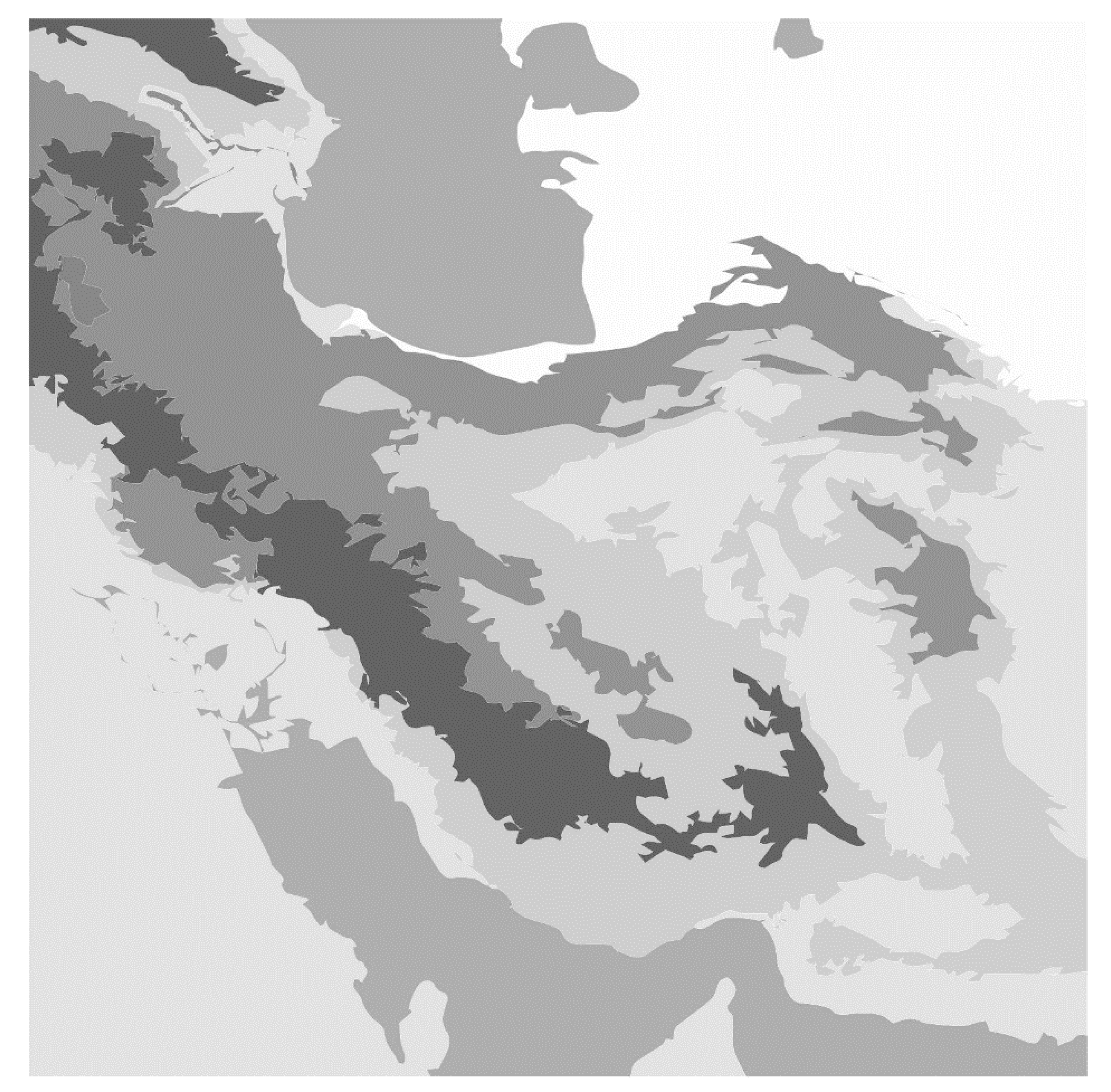
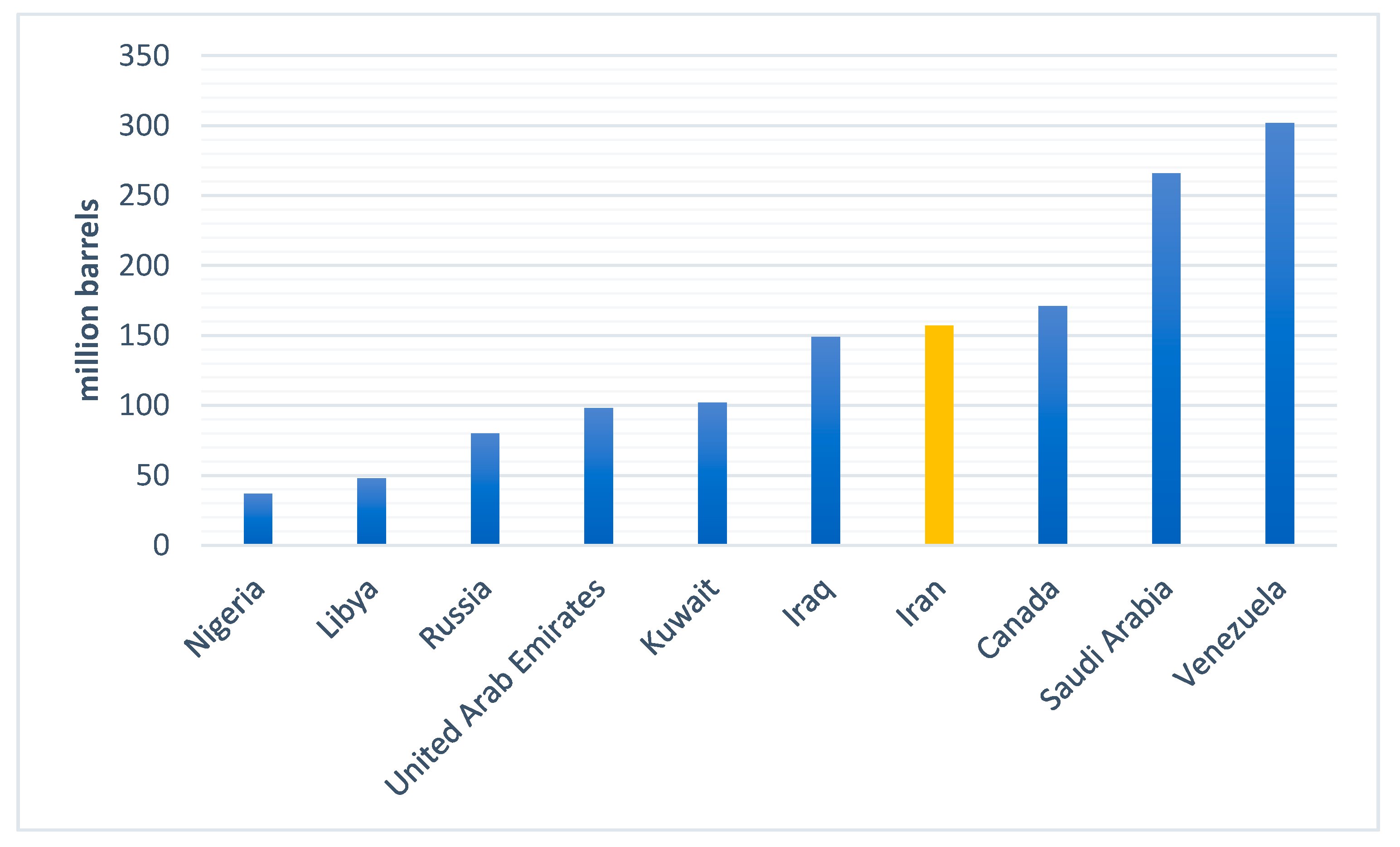
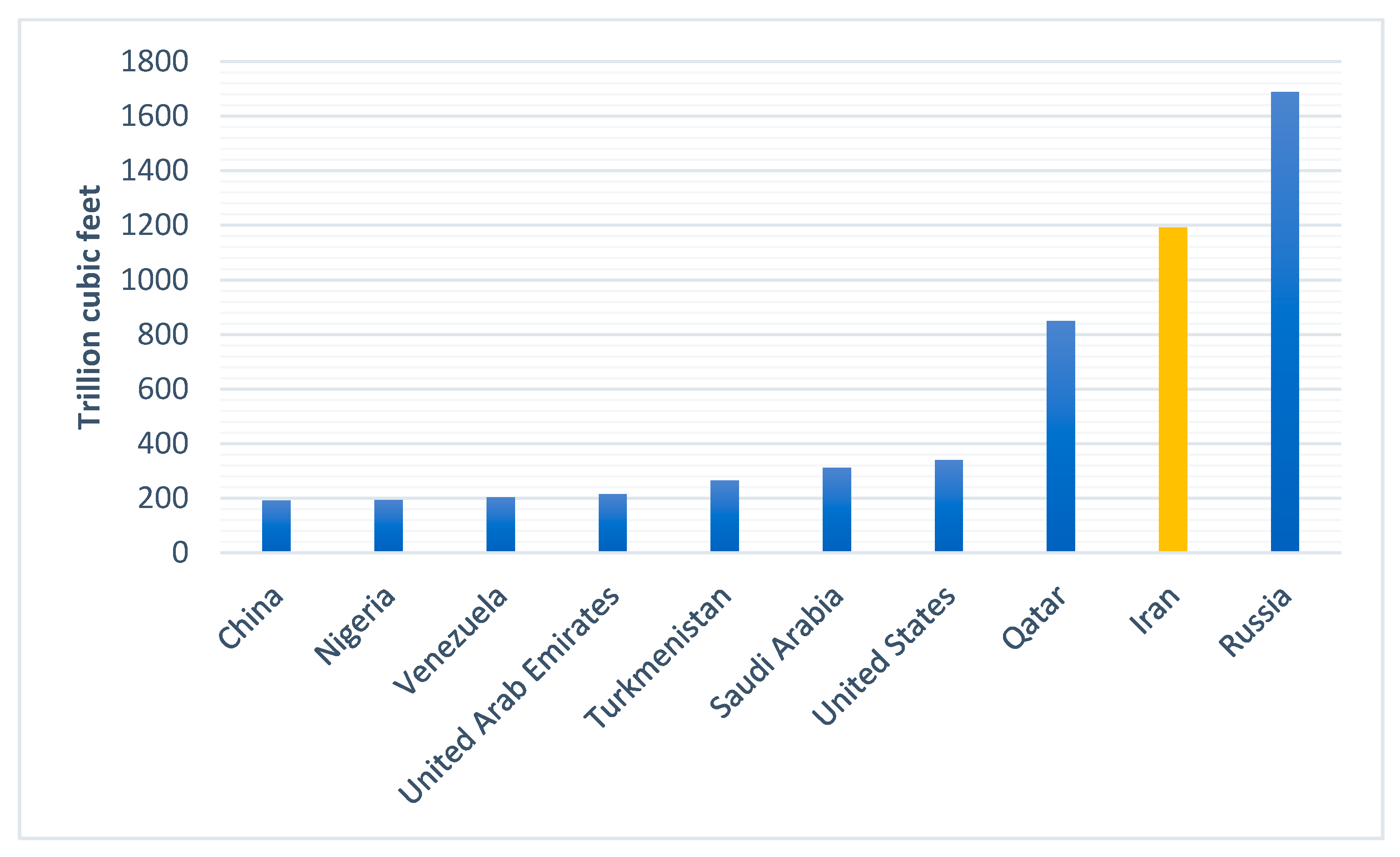


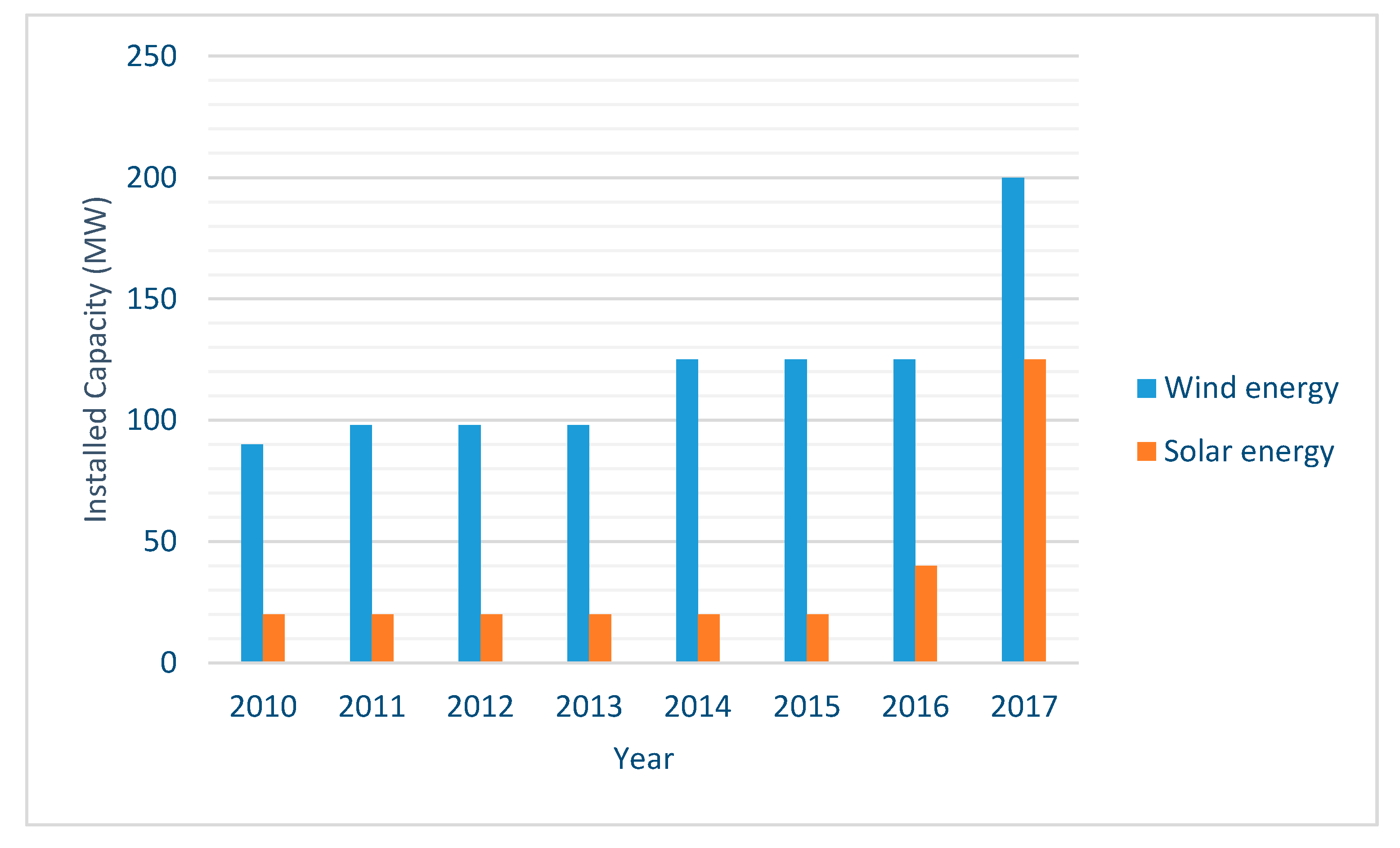
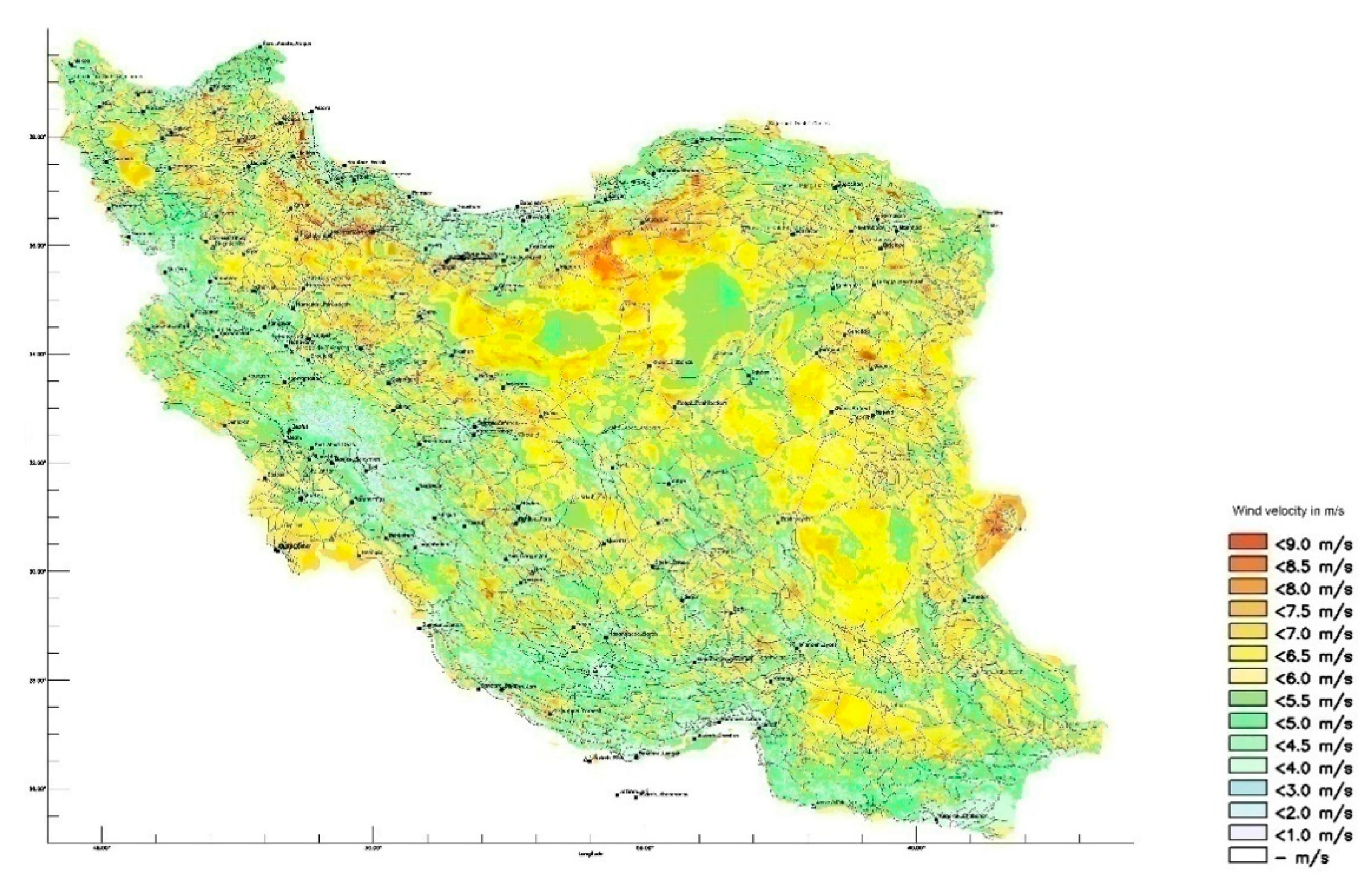
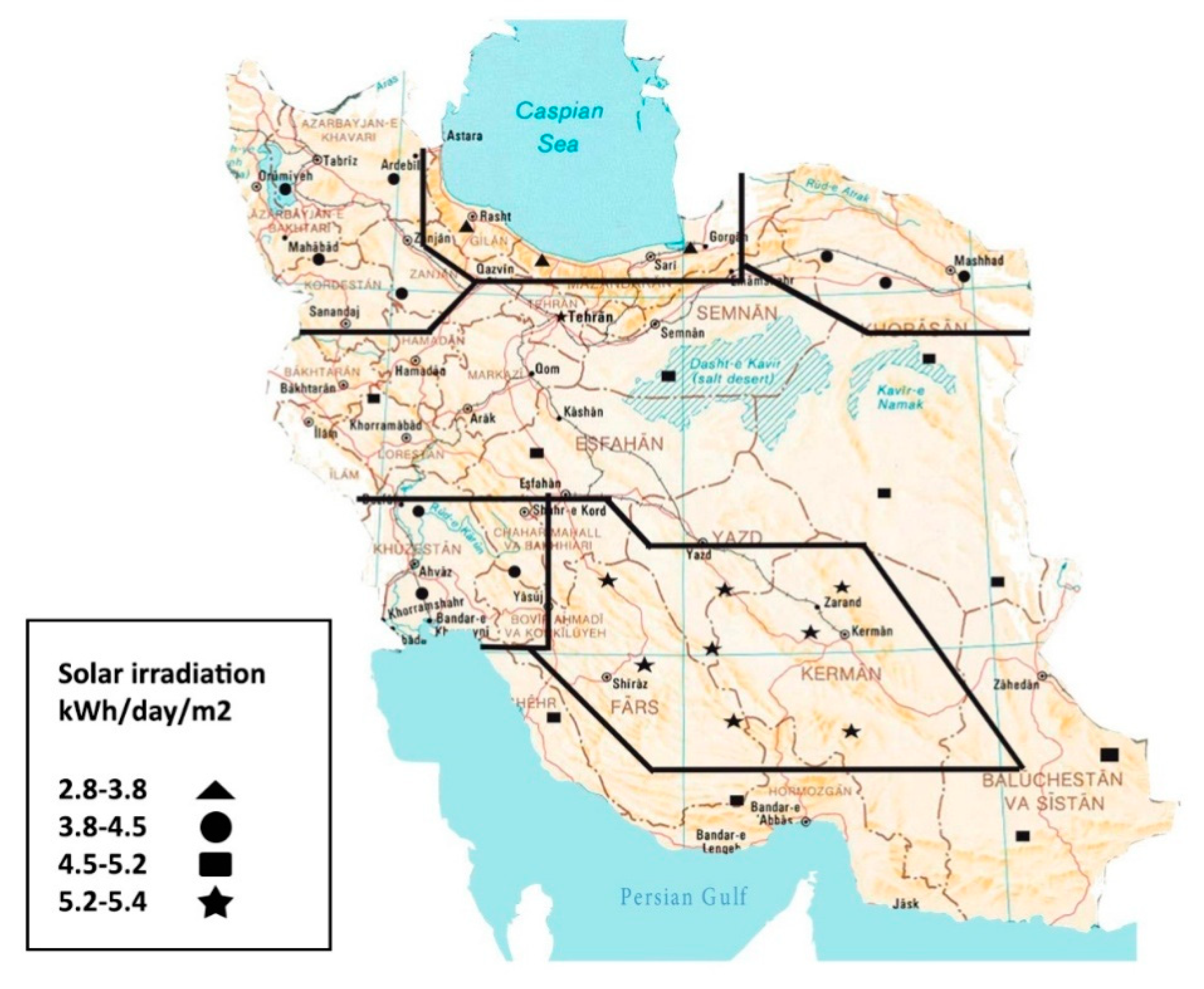
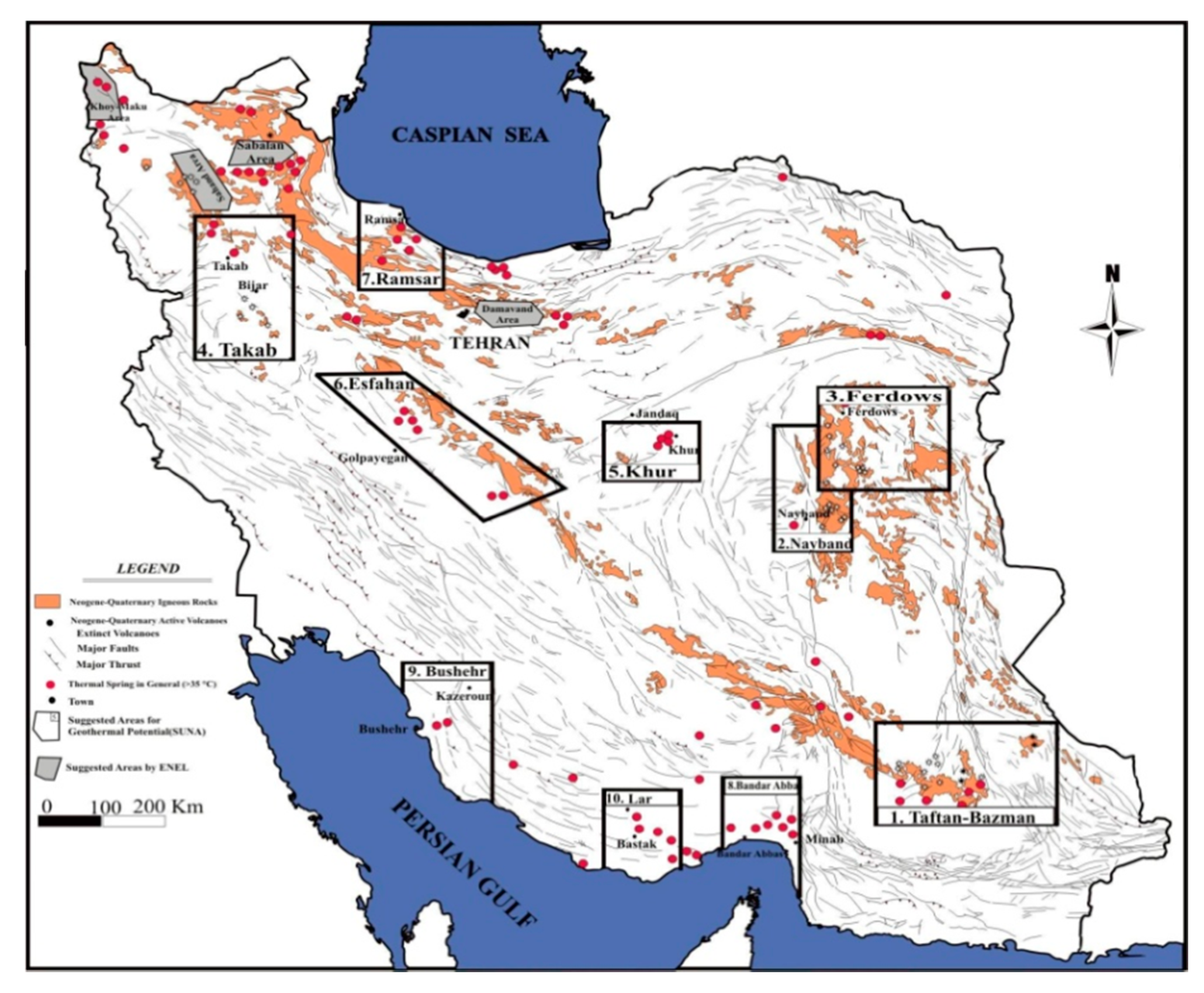

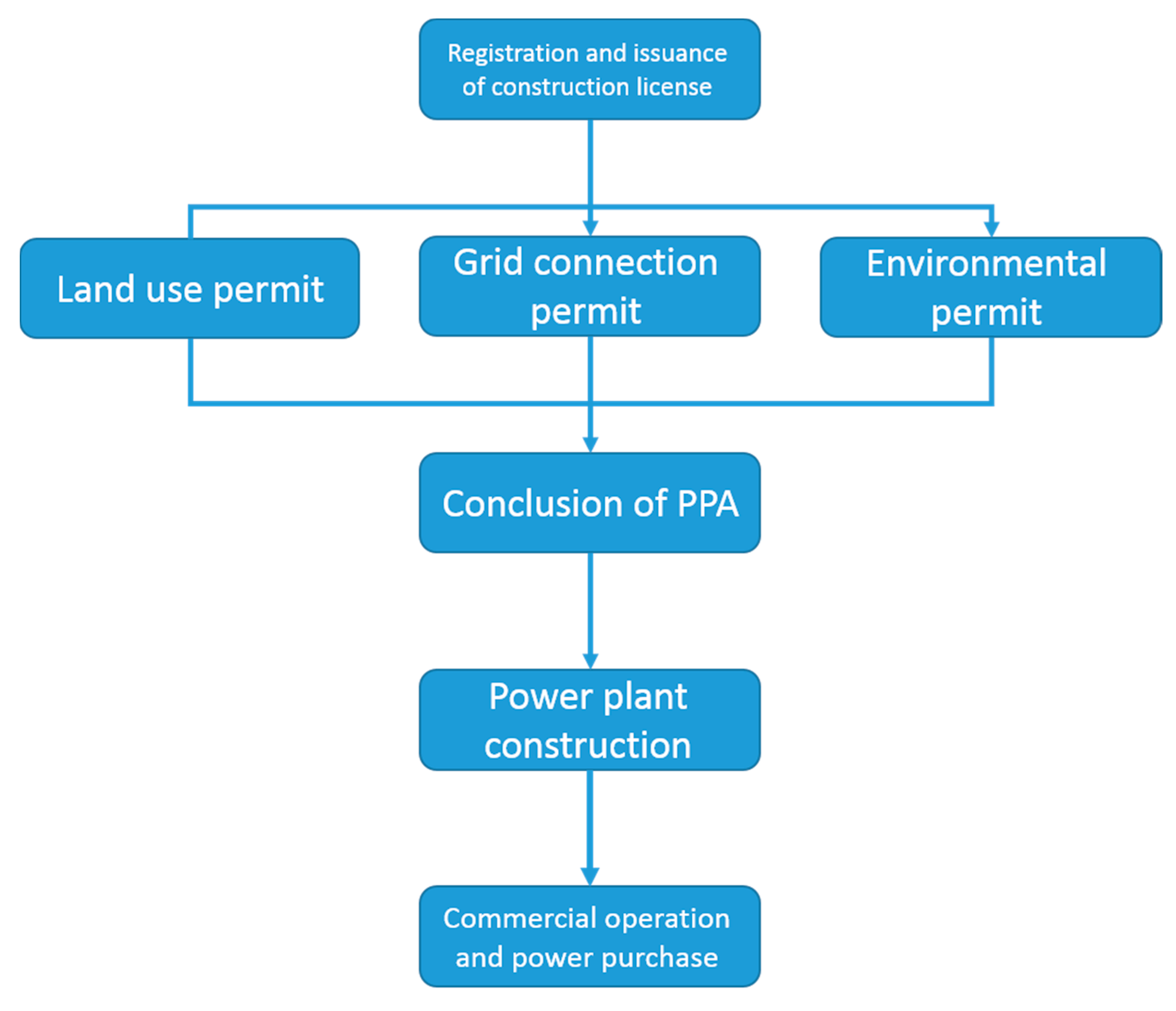
| Location | Construction Date * | Aggregate Capacity Megawatts (MW) | |
|---|---|---|---|
| Province | City/Town | ||
| Ardebil | Sarein | 2012 | 0.66 |
| Nir | 2014 | 0.66 | |
| East Azerbaijan | Aqkand | 2017 | 25 |
| Sarab | 2014 | 0.66 | |
| Tabriz | 2009 | 1.98 | |
| Fars | Shiraz | 2010 | 0.66 |
| Qazvin | Siahpoosh | 2017 | 61.2 |
| kahak | 2013–2016 | 55 | |
| Gilan | Manjil | 1994–2014 | 92.26 |
| Isfahan | Safeh | 2011 | 0.66 |
| Khorasan-e Razavi | Khaf | 2013–2015–2016 | 4.71 |
| Binalood | 2010 | 28.38 | |
| Neyshaboor | 2015 | 4 | |
| Khuzestan | Mahshahr | 2010 | 0.66 |
| Sistan and Balouchestan | Zabol | 2009 | 0.66 |
| Location | Construction Date * | Aggregate Capacity (MW) | |
|---|---|---|---|
| Province | City/Town | ||
| Alborz | Nazarabad | 2017 | 0.63 |
| Chaharmahal and Bakhtiari | Shahrekord | 2017 | 1.5 |
| Fars | Sarvestan | 2017 | 4.6 |
| Shiraz | 2017 | 10 | |
| Abadeh | 2017 | 2 | |
| Eqlid | 2018 | 10 | |
| Abadeh | 2018 | 10 | |
| Hamadan | Qahavand | 2016–2017 | 15.9 |
| Aq-Bolaq | 2016 | 7 | |
| Kordabad | 2017 | 7 | |
| Famenin | 2017 | 8.5 | |
| Kabudarahang | 2018 | 1 | |
| Hormozgan | Qeshm | 2017 | 10 |
| Isfahan | Jarqavieh | 2016 | 10 |
| Kashan | 2016 | 1 | |
| Shahreza | 2018 | 0.45 | |
| Kerman | Mahan | 2016–2017–2018 | 30 |
| Rafsanjan | 2016 | 1.2 | |
| Bardsir | 2018 | 1 | |
| Khorasan-e Razavi | Taybad | 2016 | 0.31 |
| Qazvin | Kahak | 2018 | 2 |
| Qom | Qom | 2016–2018 | 11 |
| Semnan | Damqan | 2017 | 1.31 |
| Sistan and Balouchestan | Zahedan | 2017 | 10 |
| South Khorasan | Khusf | 2017 | 10 |
| Boshruyeh | 2018 | 1 | |
| Tehran | Shahr-e rey | 2017–2018 | 12.5 |
| Damavand | 2017 | 8.4 | |
| Shams abad | 2016 | 0.22 | |
| Malard | 2014 | 0.51 | |
| Yazd | Mehriz | 2018 | 10 |
| Ashkzar | 2017 | 10 | |
| Ardakan | 2017 | 10 | |
| Dehshir | 2018 | 3.5 | |
| Chahak | 2018 | 10 | |
| Small scale systems-whole country | 6.5 | ||
| Systems constructed by electricity Subscribers | 20.47 | ||
| Location | Construction Date | Aggregate Capacity (MW) | |
|---|---|---|---|
| Province | City/Town | ||
| Gilan | Bijar | 2017 | 6.3 |
| Khorasan-e razavi | Mashhad | 2015 | 0.44 |
| Lorestan | Boroujerd | 2016 | 0.17 |
| Markazi | Arak | 2016 | 0.24 |
| Qom | Qom | 2016 | 2.7 |
| semnan | Shahmirzad | 2018 | 3 |
| Small-scale whole country | 75.35 | ||
| Location | Construction Date | Aggregate Capacity (MW) | |
|---|---|---|---|
| Province | City/Town | ||
| Fars | Shiraz | 2009 | 1.06 |
| Khorasan-e razavi | Mashhad | 2009 | 0.6 |
| Tehran | Kahrizak | 2016 | 3 |
| Abali | 2016 | 1.9 | |
| Shahr-e rey | 2010 | 4 | |
| Number | Subject Area of Study | Reviewed Papers |
|---|---|---|
| 1 | Iran and its whole energy system | [1,2,15,16,17,26,27,38]. |
| 2 | Renewable energy in Iran | [3,4,5,6,7,14,18,22,23,26,27,28,35,36,37,40,53,71,89,107]. |
| 3 | Wind energy in Iran | [11,19,20,42,51,55,56,57,58,59,60,61,62,63,64,65,66,67,68,69,70]. |
| 4 | Solar energy of Iran | [11,21,61,73,74,75]. |
| 5 | Hydro, wave, and tidal power in Iran | [31,32,33,34,81,82,83,84,103,104,105,107,109,110,111,112,113,114,115]. |
| 6 | Biomass energy and bio fuel in Iran | [13,24,25,88,89,91,92,93,94,95,96,99,100,101,102]. |
| 7 | Geothermal energy of Iran | [29,30,76,78,79]. |
| 8 | Fuel cell and hydrogen energy | [114,115,116,117,118,119,120,121,122,123,124,125,126,127,128,129]. |
| Row | Technology Type | Guaranteed Power Purchase Tariff (IRRs Per kWh) | |
|---|---|---|---|
| 1 | Biomass | Landfill | 2700 |
| The anaerobic digestion of manure, sewage and farming wastes | 3500 | ||
| Incineration and waste gas storage | 3700 | ||
| 2 | Wind farm | above 50 MW capacity | 3400 |
| capacity of 50 MW and less | 4200 | ||
| 3 | Solar farm | capacity above 30 MW | 3200 |
| capacity of 30 MW and less | 4000 | ||
| capacity of 10 MW and less | 4900 | ||
| 4 | Geothermal | including excavation and equipment | 4900 |
| 5 | Waste recycling | waste recycling in industrial processes | 2900 |
| 6 | Small hydropower plants (capacity of 10 MW and less) | Installation on the rivers and side facility of dams | 2100 |
| Installation on the pipelines | 1500 | ||
| 7 | Fuel cell systems | 4948 | |
| 8 | Turbo expanders | 1600 | |
| 9 | Wind systems | 1 MW capacity or less | 5700 |
| 10 | Solar systems | 100 kW capacity or less | 7000 |
| 20 kW capacity or less | 8000 | ||
| Strengths | Weakness |
|---|---|
|
|
| Opportunities | Threats |
|
|
Publisher’s Note: MDPI stays neutral with regard to jurisdictional claims in published maps and institutional affiliations. |
© 2020 by the authors. Licensee MDPI, Basel, Switzerland. This article is an open access article distributed under the terms and conditions of the Creative Commons Attribution (CC BY) license (http://creativecommons.org/licenses/by/4.0/).
Share and Cite
Aien, M.; Mahdavi, O. On the Way of Policy Making to Reduce the Reliance of Fossil Fuels: Case Study of Iran. Sustainability 2020, 12, 10606. https://doi.org/10.3390/su122410606
Aien M, Mahdavi O. On the Way of Policy Making to Reduce the Reliance of Fossil Fuels: Case Study of Iran. Sustainability. 2020; 12(24):10606. https://doi.org/10.3390/su122410606
Chicago/Turabian StyleAien, Morteza, and Omid Mahdavi. 2020. "On the Way of Policy Making to Reduce the Reliance of Fossil Fuels: Case Study of Iran" Sustainability 12, no. 24: 10606. https://doi.org/10.3390/su122410606
APA StyleAien, M., & Mahdavi, O. (2020). On the Way of Policy Making to Reduce the Reliance of Fossil Fuels: Case Study of Iran. Sustainability, 12(24), 10606. https://doi.org/10.3390/su122410606




